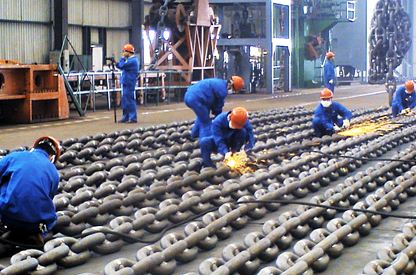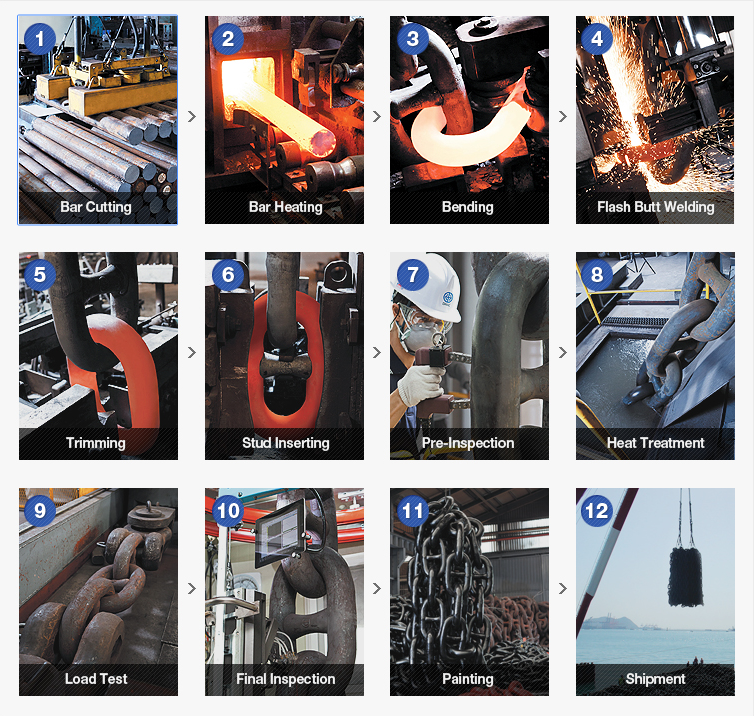
THE BASIC PROCESS GOES AS FOLLOWS:

FORMING
The raw steel rod is drawn out to the correct diameter. The chain-forming machine stamps the grade and trace code on the rod and then cuts it to the length required to form one chain link. From here a robotic sequence bends the rod into a link and interconnects it with the previously formed link. YouTube this and you can be mesmerized for hours watching robotic poetry in motion.
WELDING
The chain then passes to the welder where each link is machine welded by heating the edges of the rod ends to around 900°C and forcing them together. The excess material is trimmed to form a nice smooth link.
CALIBRATING
After the chain is formed and welded, it is calibrated to ensure the consistency of the length of each link. This is vitally important for anchor chain, as it has to fit your windlass without jamming or jumping and taking fingers with it. This process also tests the strength of the chain, especially concentrating on the welded section.
GALVANISING
The finished studless link anchor chain is then cleaned, prepped and dipped in flux solution before being dipped in a molten zinc bath. This will protect it from corrosion – but over time rough bottoms and the chain gypsy will slowly chip away at the galvanizing.
TESTING
Samples of the welded chain are cut from the production run several times per shift to be tested to verify the integrity of the weld and form. The chain is then proof-tested to twice its working load limit.
While the process of making a chain is relatively straightforward, the grading of the chain is a swirl of misinformation, conjecture and confusion. Different manufacturers use different labeling systems to grade the chain. Different distributors, retailers and even countries confuse matters more by adding their spin. The only certainty in the whole business is that eventually grades must equate to tensile strength, usually measured in megapascals (MPa).

THE BASIC GRADES ARE:
Low tensile chain:
This is G3 or G30, which means it is formed from 0.08 percent carbon steel with a tensile strength of 300 MPa. Other aliases include ‘BBB’ or ‘proof coil.’ While plenty of boats have got away with carrying this grade of anchor chain in the past, there are now better options.
Medium tensile chain:
This is G4 or G40 which means it is formed from steel with a tensile strength of 400 MPa. It contains 0.17-0.23 percent carbon steel and in the United States, this is commonly branded as 'high test', which is not to be confused with high tensile. This is the most common form of chain used by New Zealand boaties and is more than adequate for a good night's sleep.
High Tensile chain:
This is a chain made from steel with a tensile strength above 500 MPa. Most manufacturers market G7 or G70 (700 MPa) and in the United States this is referred to as the 'transport' chain. While it is lighter than G40 for a given length, you may pass out when you hear the price. With an increase in grade, the safe working load of the anchor chain will increase. This is largely due to an increase in carbon content and the degree of heat treatment the steel has received. Choosing the best grade and size depends on the windlass, the boat and its ability to handle storing the weight of the chain. When it comes time to work all this out, seek the advice of an expert.
A little education is a dangerous thing. In times past I would have laid out my anchor, set it, snubbed it, flicked the anchor light on and rolled into my bunk for uninterrupted sleep. Now I lie awake with visions of chain-forming robots, welds, tests and tensile strength numbers churning through my head while I listen to the anchor chain grinding over the bottom.





























































































































